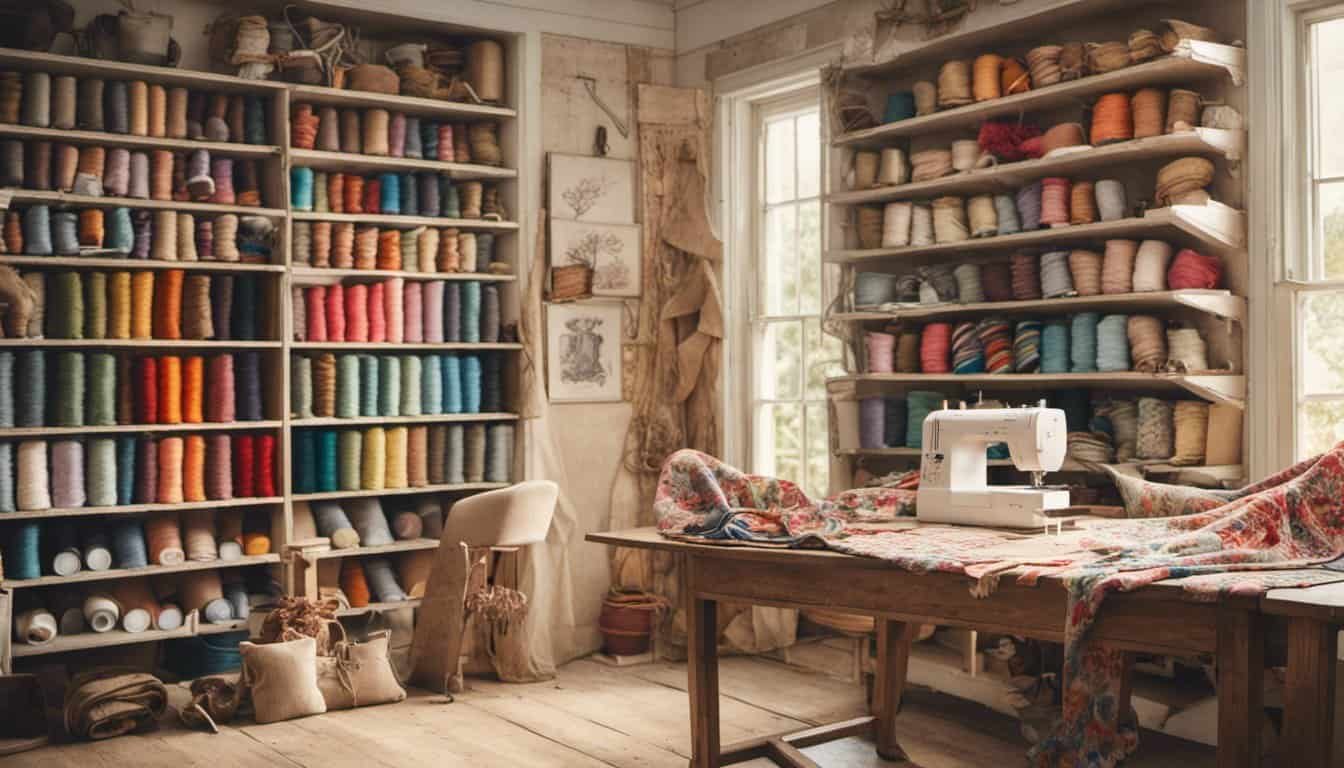Sewing denim might seem daunting at first, but it’s totally doable with the right approach. Whether you’re crafting your own jeans or customizing a jacket, working with heavy fabrics like denim opens up a world of creative possibilities.
You’ll discover essential tips and techniques that make sewing denim easier and more enjoyable. From choosing the right tools to mastering sturdy stitches, this guide has you covered. Get ready to bring your denim projects to life and enjoy the satisfaction of creating something durable and stylish.
Choosing the Right Denim Fabric
Selecting the right denim fabric is crucial for the success of your project. By considering factors like weight, fiber content, weave type, color, and stretch, you can ensure your finished item is both durable and stylish.
Weight
Denim weight affects the fabric’s durability and suitability for different projects.
- Lightweight (8-12 oz): Perfect for shirts, skirts, and summer jackets.
- Medium Weight (12-16 oz): Ideal for jackets, dresses, and lightweight jeans.
- Heavyweight (16-32 oz): Best for jeans, workwear, and upholstery.
| Weight Category | Weight Range | Suitable Projects |
|---|---|---|
| Lightweight | 8-12 oz | Shirts, skirts, summer jackets |
| Medium Weight | 12-16 oz | Jackets, dresses, lightweight jeans |
| Heavyweight | 16-32 oz | Jeans, workwear, upholstery |
Fiber Content
Denim is primarily made from cotton, but blends can offer additional benefits.
- 100% Cotton: Durable and rigid, ideal for traditional denim projects.
- Cotton-Elastane Blend: Provides stretch for added comfort, suitable for skinny jeans and fitted garments.
- Cotton-Polyester Blend: Enhances durability and wrinkle resistance, great for everyday wear.
Weave Type
The weave determines the fabric’s texture and longevity.
- Regular Twill: Features a diagonal rib, offering a classic denim look and sturdy structure.
- Selvedge Denim: Utilizes a self-finished edge to prevent fraying, often associated with high-quality, premium denim.
- Stretch Twill: Incorporates elastane fibers within the twill weave, allowing for increased flexibility and comfort.
Color and Finish
Denim comes in various colors and finishes to match your design preferences.
- Raw Denim: Unwashed and untreated, it molds to your body over time, creating unique fades.
- Washed Denim: Pre-treated with processes like stone washing or acid washing for a softer feel and worn-in look.
- Colored Denim: Available in shades beyond traditional blue, such as black, gray, and white, allowing for diverse design options.
Stretch vs. Non-Stretch
Decide between stretch and non-stretch denim based on the desired fit and comfort.
- Non-Stretch Denim: Offers a structured fit, ideal for classic styles and projects requiring shape retention.
- Stretch Denim: Contains elastane, providing flexibility and ease of movement, suitable for modern, form-fitting designs.
By carefully evaluating these aspects, you can choose the denim fabric that best fits your project’s requirements, ensuring both functionality and aesthetic appeal.
Essential Tools and Materials
Equipping yourself with the right tools and materials streamlines sewing denim projects. These essentials ensure precision and durability in your work.
Tools
- Sewing Machine: Use a heavy-duty machine with a walking foot to handle thick denim layers.
- Needles: Select size 90/14 or 100/16 denim needles to prevent breakage and ensure smooth stitching.
- Thread: Choose polyester or cotton-wrapped polyester threads for their strength and longevity.
- Seam Ripper: Keep a sharp seam ripper handy to quickly correct mistakes.
- Measuring Tools: Utilize a metal ruler and a clear measuring tape for accurate fabric measurements.
- Pins and Clips: Use heavy-duty pins or needle-nose clips to secure multiple layers of denim effectively.
- Cutting Tools: Employ a rotary cutter and a self-healing cutting mat for precise fabric cutting.
Materials
- Denim Fabric: Opt for 12-16 oz denim, suitable for jeans and jackets, depending on your project needs.
- Interfacing: Apply fusible interfacing to areas like collars and waistbands to add structure.
- Zippers and Buttons: Select high-quality hardware to ensure functionality and durability.
- Bias Tape: Reinforce edges and provide a professional finish with sturdy bias tape.
- Pocket Liners: Enhance the durability and appearance of pockets with matching or contrasting pocket liners.
- Notions: Gather essentials such as strong thread, appropriate needles, and other small sewing accessories necessary for working with denim.
Preparing Denim for Sewing
Proper preparation ensures your denim projects turn out durable and professional. Follow these steps to ready your fabric for sewing.
Cutting Techniques
Accurate cutting minimizes fabric waste and ensures precise fits. Implement these techniques for optimal results:
- Use Sharp Tools: Utilize rotary cutters or sharp fabric scissors designed for heavy fabrics. Dull blades can fray denim edges.
- Stabilize Fabric: Place a cutting mat or a second layer of fabric beneath your denim to prevent shifting during cutting.
- Pin Patterns Securely: Apply fabric weights or strong pins along pattern edges to keep pieces aligned.
- Trace Patterns Carefully: Use washable markers or tailor’s chalk to outline your pattern on the denim without bleeding.
- Measure Twice: Double-check all measurements before cutting to avoid mistakes that can compromise the final product.
Prepping Tips
- Pre-Wash Fabric: Wash and dry denim to prevent shrinkage and remove sizing agents. Use cold water and tumble dry on low heat.
- Iron Seam Lines: Press seams flat using a steam iron. This helps maintain straight stitching lines.
- Mark Carefully: Use fabric-safe markers to indicate darts, pockets, and other design elements without leaving permanent marks.
- Organize Patterns: Lay out pattern pieces systematically to maximize fabric usage and reduce waste.
- Check Fabric Quality: Inspect denim for flaws such as runs, faded spots, or inconsistencies in weave before cutting.
Sewing Techniques for Heavy Fabrics
Mastering sewing techniques for heavy fabrics ensures your denim projects are strong and professional. Implement these methods to enhance durability and achieve precise finishes.
Stitch Types
Choosing the right stitch type is crucial for heavy fabrics like denim. Use a straight stitch with a longer stitch length (around 3.0 mm) for general seams, ensuring flexibility and strength. For areas under stress, such as pocket corners or waistbands, opt for a triple stitch by sewing over the same line three times, reinforcing the seam. Zigzag stitches provide added elasticity, ideal for hemming or attaching bias tape. When handling thick layers, a walking stitch helps maintain even tension and prevents puckering.

Seam Finishes
Proper seam finishes prevent fraying and enhance the longevity of your denim garments. Double-stitched seams offer extra strength, making them perfect for seams that endure frequent wear. Apply French seams for a clean, enclosed finish, especially on visible areas like the inside of jackets or skirts. Use overlocking or a serger to trim and bind seam edges simultaneously, reducing bulk and ensuring durability. For a decorative touch, incorporate topstitching, which not only secures seams but also adds a stylish element to your projects. Always press seams flat with a steam iron to set stitches and maintain a professional appearance.
Finishing Touches
Complete your denim project with essential finishing steps that ensure durability and a polished appearance.
- Pressing Seams: Press each seam flat using a hot iron to set stitches and enhance garment structure. If you press correctly, your seams remain sharp and professional.
- Topstitching: Add topstitches along major seams and edges. For example, topstitch around pockets or hems to reinforce these areas and provide stylish details.
- Attaching Hardware: Secure buttons, zippers, and rivets firmly. Use brass or stainless steel hardware for added strength and longevity.
- Final Quality Inspection: Inspect all seams, hems, and attachments for any inconsistencies or weak points. If necessary, reinforce areas with additional stitching to ensure robust construction.
- Care Instructions: Provide care guidelines to maintain your denim’s quality. Advise washing inside out in cold water and air drying to prevent fabric shrinkage and color fading.
Common Mistakes to Avoid
Avoid these common errors to ensure your denim sewing projects turn out professional and durable.
Using the Wrong Needle
Selecting the correct needle type is crucial. Use a heavy-duty denim needle (size 90/14 or 100/16) to penetrate thick fabric without breaking. A regular needle can bend or skip stitches, weakening seams.
Incorrect Thread Choice
Choose a strong, polyester or cotton-wrapped polyester thread. Weak threads may break under stress, causing seams to fail. Avoid using standard cotton thread, which lacks the necessary strength for heavy fabrics.
Inadequate Seam Allowance
« 10 Secrets on How to Press Wool Fabric Without Damage – Number 7 Will Surprise You
What Is Fast Fashion and How Sewing Helps – The Shocking Truth Revealed »
Maintain a consistent seam allowance, typically 5/8 inch (1.5 cm). Inconsistent allowances can lead to uneven seams and structural weaknesses. Use seam guides on your sewing machine to ensure uniformity.
Skipping Fabric Stabilization
Denim can shift during sewing. Stabilize fabric by using clips or pins instead of needles, which can leave marks. Ensure patterns are firmly held in place to prevent misalignment and puckering.
Ignoring Pre-Washing
Pre-wash denim to prevent shrinkage and color bleeding after sewing. Skipping this step may result in garments that no longer fit or have uneven dye.
Overlooking Pressing Techniques
Press seams as you sew to maintain straight lines and professional finishes. Neglecting to press can cause bulky seams and reduce the overall appearance of your project.
Using Incorrect Stitch Length
Set your machine to a longer stitch length (3 to 4 mm) for sturdy seams. Short stitches can fork and weaken under stress, leading to seam failure.

Neglecting to Reinforce High-Stress Areas
Reinforce areas like pockets, seams, and buttonholes with additional stitching or backstitches. High-stress zones are prone to wear and tear, and reinforcement ensures longevity.
Not Testing on Scrap Fabric
Always test your settings on scrap denim before starting your project. This practice helps you adjust tension, stitch length, and needle type to suit your specific fabric.
Rushing the Sewing Process
Take your time to ensure accuracy in cutting, stitching, and assembling. Rushing can lead to mistakes like uneven seams, misaligned patterns, and compromised garment structure.
By avoiding these mistakes, you’ll enhance the quality and durability of your denim sewing projects, resulting in professional and long-lasting creations.
Conclusion
Now that you’ve explored the essentials of sewing denim you’re ready to start your heavy fabric projects. Embrace the creativity and enjoy making durable and stylish pieces that reflect your personal style. Remember that patience and practice are key when working with these robust materials. Don’t be afraid to experiment and customize your designs to suit your needs. With the right tools and techniques you can transform thick denim into garments and accessories that stand the test of time. So grab your fabric and let your sewing journey begin. Happy crafting!


















